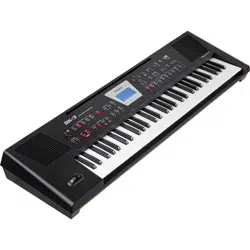Loading ...
Loading ...
Loading ...

Programming Your Own ONE TOUCH Settings (One Touch Edit)
27
Programming Your Own ONE TOUCH
Settings (One Touch Edit)
The BK-3 allows you to save your own ONE TOUCH settings, which may
come in handy for CUSTOM rhythms for which there are no “presets”. The
following operation saves the rhythm and its (new) ONE TOUCH settings
to the “My Rhythms” folder on the USB memory connected to the USB
MEMORY port.
NOTE
Never remove a USB memory while this unit is turned on. Doing
so may corrupt the unit’s data or the data on the USB memory.
NOTE
Carefully insert the optional USB memory all the way into the
port until it is rmly in place.
1. Connect an optional USB memory to the
BK-3.
After a few seconds, the display shows the
contents of the USB memory. This page is of no
importance here.
2. Press and hold the [ONE TOUCH] button. The display
changes to:
Upper tone
Lower tone
This “One Touch Edit” page can also be selected via
the BK-3’s menu.
3. Use the [UP] , [DOWN], [INC] and [DEC] buttons to select
the ONE TOUCH memory you want to change, and conrm
with the [ENTER] button.
The display changes to:
(Here, ONE TOUCH memory 2 has been selected for editing.)
TIPS
You can also select the desired ONE TOUCH memory by rst
pressing the [ONE TOUCH] button and then one of the ashing
TONE buttons [1]~[4].
4. Change the required settings.
As soon as you change any setting, the display alerts you to the fact
that the contents of the selected memory no longer corresponds to
the current settings (“EDITED”):
5. Use the [UP] and [DOWN] button to select the memory
where you want to save your new settings.
6. Press the [WRITE] button.
The display changes to:
NOTE
The above message is only displayed the rst time you press
[WRITE] after editing a ONE TOUCH memory.
7. To save your ONE TOUCH changes, use the [INC] and
[DEC] button to select “Yes” and press [ENTER].
The display shows the “Executing” message and then “Operation
Complete”.
Select “No” and press [ENTER] if you don’t want to save your
changes after all.
If the “My Rhythms” folder on the USB memory already
contains a rhythm le of the same name…
In that case, the display shows the following message when you
select “Yes” and press [ENTER] (see above):
What a One Touch memory saves
Group Parameters Parameter
Front Panel (button status)
• VARIATION [1], [2], [3], [4]
• [AUTO FILL IN]
• [INTRO/ENDING]
• [SYNC START]
• [SPLIT]
• [DUAL]
• [MELODY INTELL]
‘Performance Edit’ ’Tone Part View’ (p. 43).
All except for “Key Touch“
‘Performance Edit’ ’Tone Part Mfx’ (p. 46).
All
‘Performance Edit’ ’Split’ (p. 47).
All
‘Performance Edit’ ’Arranger Setting’ (p. 48).
• Arranger
• Zone
• Type
‘Performance Edit’ ’Melody Intelligent’ (p. 50).
All
Loading ...
Loading ...
Loading ...
